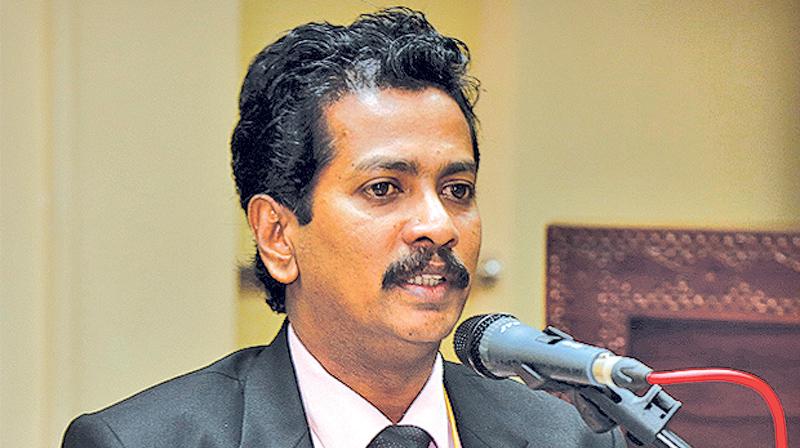
The Faculty of Computing and Technology of the University of Kelaniya hosted an international conference on sustainable development goals (SDGs) which the UN has recommended for developing countries in Asia and Africa to adopt as the development goals of their respective economies.
The keynote speech at this conference, Kelaniya International Conference on Advances in Computing and Technology (KICACT 2017) was delivered by Prof. Subarna Shakya of the Institute of Engineering of the Tribhuvan University of Nepal. Prof. Shakya addressed the conference on the topic of sustainability through cloud computing technology. This was followed by a presentation on the theme of sustainable energy development for Sri Lanka by the President of Private Sector Engineer’s Society ( PSES) Eng. Ananda Devasinghe.
Selecting goal No. 7 set by the UN, which is assure access to affordable, reliable, sustainable and modern energy for all, Ananda Devasinghe dealt with the strategy of energy development for the Sri Lankan economy in the yet to be developed, but crucial segment of renewable natural resources for power generation for the sustainable development, for the next decade of the country attaining the SDG set by the UN, underscoring the crucial role that energy development can and should play in the anticipated socio-economic development of Sri Lanka.
Renewable resources
 Devasinghe focused on the main areas of the renewable resources that Sri Lanka is blessed with, namely solar, wind, sea waves and bio gas. Being a tropical island surrounded by a vast ocean, with sun, wind and waves plus bio-gas from farms and factories and managed forestry offer a vast potential yet to be tapped for generating energy for all.
Devasinghe focused on the main areas of the renewable resources that Sri Lanka is blessed with, namely solar, wind, sea waves and bio gas. Being a tropical island surrounded by a vast ocean, with sun, wind and waves plus bio-gas from farms and factories and managed forestry offer a vast potential yet to be tapped for generating energy for all.
He said that the private sector can play an important role in sustainable energy development through the PPP model.
Elaborating on the aspects of affordability and reliability, he pointed out the strategic importance of moving out of the dependency on expensive and polluting imports of oil and coal and moving into renewable and non-polluting alternative sources for electricity generation, and the technology involved in using solar, wind and bio material to ensure affordability and reliability is available, but needs to be adopted to suit local conditions and the mass of rural sector users. This needs to be achieved through R & D. This is where the private sector, universities and even school communities can make a strategic move in the development and adaptation of local natural and renewable resources for lighting and heating purposes.
Energy is power
Adopting science and technology on a wider scale in education from school level to universities and working through R & D with private sector participation can make the quantum jump in the transition from oil and coal to local renewable sources of energy generation. In this, technological changes are modernization, value addition and quality assurance within agriculture, industry and service sectors. The availability of a cheap source of energy on a wide scale, would encourage people to adopt new energy sources, thus setting off an enterprise revolution.
Thus energy development using new natural renewable sources in Sri Lanka can prove to be the most powerful variable in the development equation. Energy is power and making it affordable and reliable would render it as the most pervasive in techno-economic changes, scoring high on socio-economic fronts.
Explaining the need to change from the present middle income level of $2,500 to $7,250 per capita national income to the upper middle income level of $7,250-$11,750, the Sri Lankan economy needs to change on a broad front and adaptation of cheap energy would propel the production and distribution sectors enabling the country to a achieve all the 17 sustainable development goals set by the UN.
Progress
In fact, Sri Lanka has made steady progress in many of the goals in the past decades by the early adoption of the overall welfare state policy package such as free education and free health services since 1948.
But today, the need is to improve the quality and efficiency of these, in keeping with global changes. An important critical factor of cost on the one hand and pollution as a negligible factor on the other have come to the forefront. Hence Devasinghe’s thrust was the development and adaptation of affordable and reliable alternative source of energy in Sri Lanka and to move away from oil and gas for electricity generation.
This transition can be achieved through a broad front of R&D involving public and private sector participation (PPP) in future energy development in Sri Lanka.
Sri Lanka’s proposed quantum jump to upper middle income level ($7,250-11,750) adopted by the present government is quite possible given the setting that is already in sight.
This jump needs massive efforts on the part of the people as well as the government in changing the energy mix from total dependence on imported sources (oil and coal) to locally available sources such as solar, wind and bio mass from managed forestry.
Development in this sector should be through a PPP mechanism. Some activities in this area have already taken place and need very forceful strategy involving universities, school communities, social organizations and private sector participation, this is the most hopeful strategy that Sri Lanka can come out with for the anticipated quantum jump.
